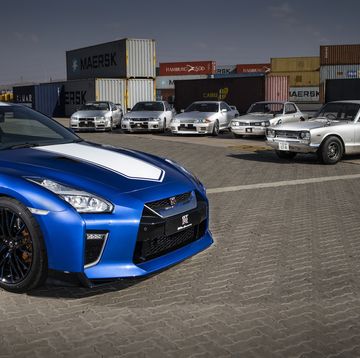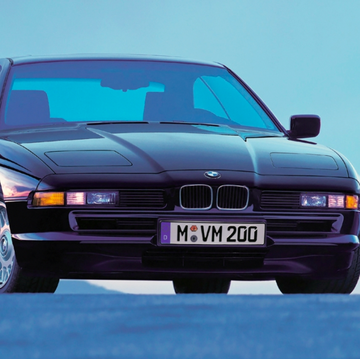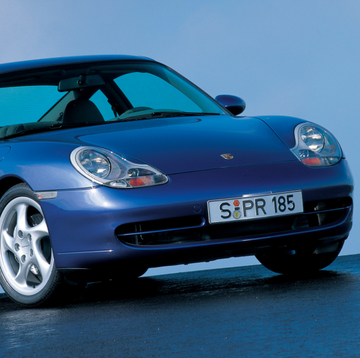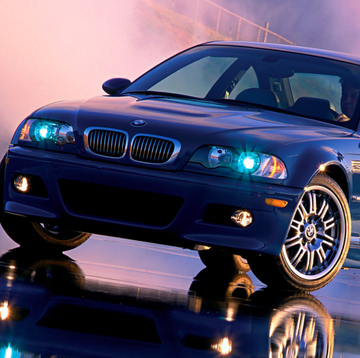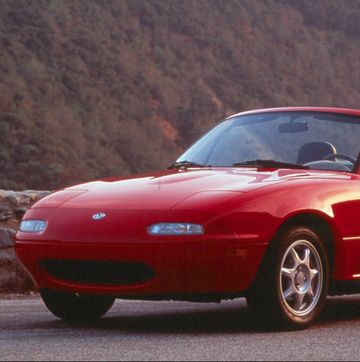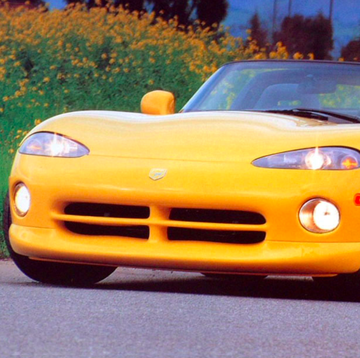When the Lotus Elise finally made it to U.S. shores in 2004, it blew minds. With an ultra-light mid-engine layout, reliable Toyota power, and wild looks, it was a smile-inducing exotic people could actually afford. Nowadays, a used Elise costs about as much as a new Avalon, making it an appealing choice for a wide range of enthusiasts.
Thinking about picking up an Elise as your next weekend toy or track weapon? Awesome to hear. Here’s how to find the right one.
A Game-Changer
Though the Elise went on sale in Europe in 1996, it wasn’t until the introduction of the fully redesigned S2 generation that Lotus decided to import it into America. Though slightly larger than its S1 predecessor, the car tipped the scales at just 1950 pounds in base form thanks to an aluminum chassis and fiberglass body panels. In a world where even the cheapest, lightest Porsche Boxster weighed nearly half a ton more, it was a genre-breaker. Exotic mid-engine proportions, a bold insect-like face, and a selection of brash color schemes allowed it to stand out even among the most expensive supercars, while a reliable Japanese drivetrain meant owners could use the car to its fullest without worry of blowing something up.
The engine-transmission combo came straight out of the then-new Celica GT-S. The 2ZZ 1.8-liter naturally aspirated inline-four sits transversely behind the cabin, with 16 valves, dual overhead cams, variable valve timing, and variable valve lift. The only changes made for Elise duty were a revised intake system, a new exhaust, and a Lotus-tuned ECU. Those changes added up to 190 horsepower at 7800 rpm and 138 lb-ft of torque at 6800 rpm, with a redline of 8500 rpm. Getting that thrust to the rear wheels is an unmodified Toyota six-speed manual.
Though cornering is the Elise’s strong suit, straight-line speed wasn’t too shabby either, thanks to the lightweight design. We measured zero to 60 mph in 4.7 seconds during our testing back in ‘04, with a top speed just under 150 mph.
Elises were offered with two big-ticket options. The first, the Touring package, added leather seats, power windows, full carpeting, and more sound-deadening, all of which added around 15 pounds of weight. The Sport package, on the other hand, got you 10-percent stiffer springs, height-adjustable shocks, sticky Yokohama tires, and forged aluminum wheels that saved 20 pounds in total over the standard wheels. And if you didn’t like the roll-up black canvas top, a color-matched removable targa hardtop was available as an option.
For 2006, Lotus expanded the Elise’s option sheet with the availability of a limited-slip differential, traction control, black-painted wheels, and the ability to delete the air conditioning. There were also a number of detail improvements. More comfortable Probax seats were standard along with LED taillights. It also switched to drive-by-wire and received a new pedal box. From 2006 onward, buyers could also option the forged wheels from the Sport pack as a standalone add-on.
The Elise got a mild refresh in 2008, with the biggest change being the availability of a supercharger. The Magnusson-built M45 Roots-type unit added 26 pounds to the car’s overall weight, but also brought output up to 218 horsepower and 158 lb-ft of torque—a substantial jump over the base car’s stats. Other changes from 2008 onward were a revised gauge cluster with inverted colors, an updated multi-function display, and three-tier shift lights, as well as an iPod adapter and a cup holder on the Touring package and lighter bucket seats for the Sport package.
The U.S.-market Elise’s biggest change came right before its exit from the market, when the model got a facelift for 2011. The last America-bound Elises got a new, singular headlight design meant to mimic the bigger, more expensive Evora; the design tweak also reduced aerodynamic drag by four percent. Additionally, the 2011 model got a new bumper and two new sets of wheels—one cast, and one forged. Lotus claims the forged wheels weigh 64 pounds per set, which is pretty impressive.
Lotus sold a few special edition Elises in the U.S. throughout its lifecycle, including the race-inspired Type 72D, the California Edition, the 60th Anniversary edition, and the RGB edition, built in tribute to Lotus’s former director of vehicle engineering, Roger Becker.
So Which One Is Right for Me?
If you’re in the market for an Elise, chances are you’re already willing to give up some livability for the sake of performance. But if you'd like to have basic features like sound insulation and power windows, make sure to find a Touring package car. Similarly, if you plan on doing a bunch of closed-course performance driving (think track days or autocross), prioritize cars optioned with the Sport package. Price-wise, used naturally aspirated Elises seem to always hover around the $30,000 range if they haven’t been in any sort of accident, regardless of mileage, color, or options. There are always outliers, however.
Not satisfied with the standard 190 horsepower from the naturally aspirated Toyota engine? Supercharged Elises are rarer than their base counterparts, and often command a steep premium on the used market. If you’re dead-set on an Elise SC, also consider its more hardcore sibling, the Exige. Unlike the Elise, the Exige got an intercooler from the factory, meaning even more power from that 1.8-liter engine. But be prepared to spend more if you do go that route.
If you’re in love with the more modern face of the 2011 Elise, you have to be willing to wait, as Lotus sold just a few examples here in its final model year; they rarely come up for sale. And like supercharged models, last-year Elises demand a heavy premium. Considering the driving experience is near identical, we’d recommend saving the cash and getting an earlier car (unless you really hate the quad-headlight look).
And before you convince yourself you absolutely must have a limited-slip differential in your Elise, consider this: When the LSD was first made available as an option, Lotus recommended getting it only if the car was to be used on demanding, tight circuits. Why? The company says the LSD can take away from the balanced nature of the car at speed. Mechanical limited-slip diffs will always generate a bit of inherent understeer. It’s part of the reason why Lotus waited until the Evora 400 to offer a standard-equipment LSD on one of its production cars.
What Should I Look Out For?
While the drivetrain is from Toyota and generally bulletproof, the Elise is still a British sports car. And sadly, it hasn’t escaped the unreliability stereotype associated with British machinery. Aging electronics can cause problems over time, while interior trim pieces can become brittle and crumble, or cause squeaks and rattles. The trunk release cable can snap, and on early cars, the side windows can fall out of alignment. There was even a recall to fix gear shifters that broke during normal use. Water getting into the cabin through the roof’s weather stripping is common, so if you plan on owning an Elise, we’d suggest garaging it.
If you plan on bringing your Elise to the track, there are a few more things to look out for. Brake rotors are said to have a short life, so make sure you check them before you buy. In a small number of cases, owners who have tracked their Elise have reported toe link failures in the rear suspension. Something to keep in mind, at minimum.
Perhaps the most infamous weak point of the Elise, however, is the body itself. The front bodywork consists of a single large fiberglass clamshell; the same is true for the rear. As many owners have found out the hard way, it can be prohibitively expensive to repair or replace one of these pieces. A small fender-bender in an Elise often ends in the car being totaled by the insurance company, simply because sourcing, painting and installing a new clamshell could cost more than the car is worth. It’s part of the reason you might see a bunch of Elises on the market with salvage or rebuilt titles.
What About the Community?
Since comparatively few Lotuses were sold in the U.S., the marque doesn't enjoy the sort of massive, nationwide coverage of owner’s clubs, regional events, and meet-ups you'd find with more mainstream models. But if you live in or near a metropolitan area, there’s a good chance you’ll have access to small clubs or groups of like-minded owners who will be thrilled to share their Elise enthusiasm with you. You'll just have to do a bit more searching to find them.
Moreover, online forums such as LotusTalk.com give owners around the world a platform to share pictures and tech tips about their cars, so even if there isn’t another Lotus owner for hundreds of miles, you can still find people to converse with.
Check out the rest of our buyer's guides right here!

Brian Silvestro is Hearst Autos' Lead Deputy Editor for rankings content. He spent over seven years as a staff writer for Road & Track Magazine, and still contributes regularly with car reviews, industry interviews, and more.
He also has a taste for high-mileage, rusted-out projects and amateur endurance racing.








